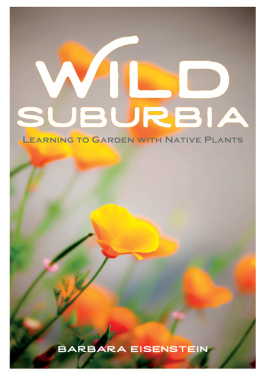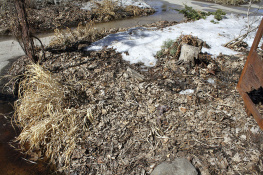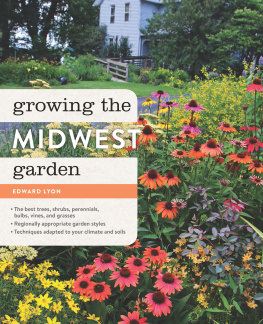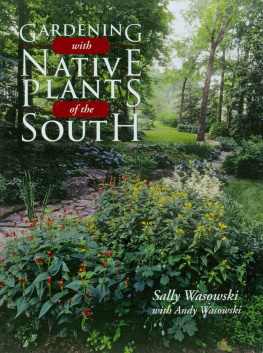NATIVE PLANTS OF THE MIDWEST
A Comprehensive Guide to the Best 500 Species for the Garden
Alan Branhagen
Timber Press
Portland, Oregon

To parents, family, teachers, friends, colleagues, and mentors who give added time and resources to inspire learning and open doors of opportunity.
Copyright 2016 by Alan Branhagen. All rights reserved.
Published in 2016 by Timber Press, Inc.
The Haseltine Building
133 S.W. Second Avenue, Suite 450
Portland, Oregon 97204-3527
timberpress.com
Jacket design by Laken Wright
Library of Congress Cataloging-in-Publication Data
Names: Branhagen, Alan, author.
Title: Native plants of the Midwest: a comprehensive guide to the best 500 species for the garden / Alan Branhagen.
Description: Portland, Oregon: Timber Press, 2016. | Includes bibliographical references and index.
Identifiers: LCCN 2016009571
Subjects: LCSH: Native plants for cultivationMiddle West. | Endemic plantsMiddle West.
Classification: LCC SB439 .B63 2016 | DDC 635.9/5177dc23 LC record available at http://lccn.loc.gov/2016009571
A catalog record for this book is also available from the British Library.
eISBN: 9781604697773
Contents
Foreword
I first met the author in the winter of 1980 when I was a graduate student teaching assistant for a plant taxonomy lab in the Botany Department at Iowa State University. I noticed Alan would always leave early, which usually is the sign of a mediocre student. A brief conversation with him proved that just the opposite was the caseAlan was a great student who already knew much of what we were teaching! He was leaving early to visit the university library or nearby Ledges State Park to learn more about plants. In subsequent years Alan was very generous in sharing with me his knowledge of the native plants of his beloved Upper Iowa River valley in northeast Iowa and elsewhere in the Midwest.
Generations of gardeners in the Midwest have focused on cultivated plants from Europe and Asia. This book is part of a wonderful growing trend, the return to gardens of native plants that are part of our natural heritage. Alan has learned a lot about native plants, gardening, and landscape architecture over the years and shares his knowledge with us. He reveals in these pages that the native plants of the Midwests prairies, forests, and wetlands have much to offerwonderful colors, shapes, sizes, textures, blooming and producing fruits at different times of the year, and locally grown for food.
Alan emphasizes that native plants not only have much to offer to gardens from a horticultural perspective, but they can also greatly add to our enjoyment by attracting native birds and insects. An iridescent ruby-throated hummingbird, bill deep, sips nectar as it hovers in front of a cardinal flower; black and orange banded Baltimore checkerspot larvae feed communally on turtlehead inside an envelope of silk; leaf miners trace intricate, meandering patterns while feeding within the thin leaves of columbine. These animals add color, a range of shapes and sizes plus the element of motion that enhance a gardens potential to be a more diverse, interesting, educational, and vibrant part of our lives. With the loss of so much native habitat in the Midwest to agriculture and development, gardens can even become a way to increase the chance that some of these species will be present for future generations to enjoy. The native plants in our gardens can also inspire us to assist public and private conservation organizations in preserving native habitat, now more important than ever in our fast changing world.
Read this book and be inspired by Alans advice and photographs to return native plants to your garden. Follow these plants through the growing season to appreciate the changes in color and form as they progress from buds to flowers to fruits before resting in their winter mode. Learn to enjoy and share them with your neighbors, not just the humans, but also the animals native to your portion of the Midwest.
Mark Leoschke
Botanist, Wildlife Bureau, Iowa Department of Natural Resources
Preface
As a young child, native plants grabbed my attention with their uniqueness; I found them more special and intriguing than popular garden flowers. The very first flower I remember was Dutchmans breeches on a walk at a local park. My mom pointed out that each flower looked like little pants. I inspected them closely: they were upside down, inflated, sparkling white, and even-layered. Dutchmans breeches remains one of my favorite plants to this day and I cant imagine spring without a romp to experience it in the glory of its native haunts. Now I know its natural history and taxonomy and that adds to its appeal.
As a budding young naturalist interested in all things living wild, I scoured our Iowa neighborhood collecting butterflies, moths, old bird nests (which I now know is not legal), and tree leaves. At age 8, I walked all over the neighborhood on a mission to collect the leaf of every tree I knew, which included bur oak, American elm, sugar maple, and rarities like Ohio buckeye, sycamore, and tulip tree. Our Encyclopedia Britannica helped with identifications.
Keenly aware of the living things around me, I remember the plants at my maternal grandparents home more than anything else about the farm. Norway spruce created the windbreak. Eastern white pines, an Ohio buckeye, and black cherry grew around the house. Thickets of American plum and chokecherry marched along the driveways hedgerow where I found prized cecropia cocoons, North Americas largest moth. Plum blossoms perfumed the spring air while their fruit tasted sweet in late summer. To this day, the scent of plum blossoms recalls the laugh of my grandmother and the delicious apple-plum preserves she made.
Native plants taught me to live in the moment by enticing me to closely inspect their architecture and the goings-on around them through the seasons. I learned by observation what plants hosted various caterpillars and knew where to find milkweed for treasured monarch caterpillars. I observed that some plants were no place to look for wildlife treasures.
Whorled milkweed attracted so many bugs while it bloomed that it became my summertime favorite. I caught various insects on its strikingly scented white flowers; wasps were a daring thrill to catch without getting stung. I vividly remember observing a nectaring Gulf fritillarya rare vagrant butterfly that far north. The resident fritillariesmeadow, Aphrodite, and great spangledwere familiar butterflies. Whorled milkweed inspired me to put together a list of flowers that attracted butterflies way before I found any book describing butterfly nectar plants. Whenever I smell a blooming whorled milkweed, I am transported back into those childhood days.

Dicentra cucullaria (Dutchmans breeches) flowers resemble tiny pants.
When I was an early teenager, my world expanded from an edge-of-town neighborhood to a rural golf course as my parents changed careers to manage it. You would think that would have made me interested in turf grass and landscape maintenance, but this was no typical golf course. Its fairways sat on a ridge top crest surrounded by stands of native paper birch and the courses periphery was wild woodlands like nothing I had seen before. I encountered a diversity of native plants and animals that were simply astounding, as neither plow nor cow had touched it, and humans stayed on the links.









